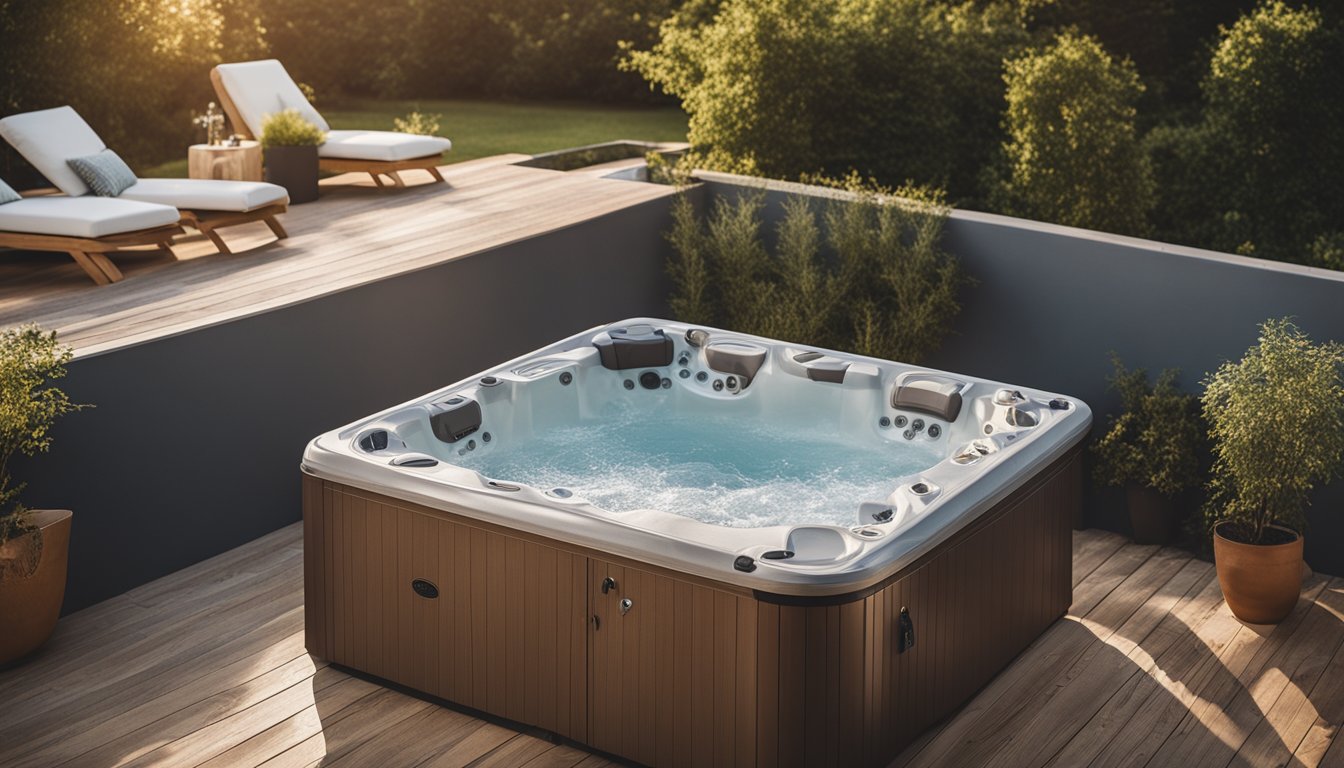Late updated: 22 Aug 2024 15:08
Written by: James Whitaker
Choosing The Best Cover For Your Hot Tub: Essential Factors to Consider
Choosing the best cover for your hot tub is essential for maintaining both its functionality and longevity. A high-quality hot tub cover can offer superior insulation, protecting your spa from the elements and reducing your energy costs. With so many options on the market, finding the right one might seem daunting, but focusing on materials, fit, and insulation properties can guide your decision.

We've discovered that durable materials like 600D Oxford fabric with a waterproof PVC coating provide excellent protection. Adjustable features such as drawstrings enable a snug fit, safeguarding your spa against debris and weather. From custom-fit designs to robust, slope-sided models, the choice depends largely on your specific needs and environmental conditions.
Understanding the importance of American Society of Testing and Materials (ASTM) certifications can also simplify your search. Certified covers ensure consistency and safety, making them a reliable choice. Whether you aim to enhance your spa's lifespan or reduce maintenance effort, choosing the right cover is an investment that pays off.
Key Takeaways
- Quality hot tub covers offer insulation and protection, reducing energy costs.
- Durable materials and adjustable features ensure a secure, long-lasting fit.
- ASTM-certified covers guarantee reliability and safety.
Selecting the Right Hot Tub Cover
Choosing the best hot tub cover involves understanding the importance of fit and insulation, the durability of materials, and the benefits of various design features. The right cover ensures your hot tub remains energy-efficient, well-protected, and long-lasting.
Understanding the Importance of Fit and Insulation
A well-fitted hot tub cover is crucial. The dimensions must match the size and shape of your hot tub exactly. Accurate measurements prevent heat loss, contribute to energy efficiency, and ensure optimal insulation. Poorly fitting covers allow heat to escape, leading to higher energy bills and reduced performance. Ensuring a snug fit means we can keep our hot tub insulated and running efficiently.
Custom covers tailored to your specific hot tub model can be beneficial. They snugly fit every contour, providing superior insulation. High-quality insulation, such as expanded polystyrene (EPS) foam, locks in heat effectively. This material is both lightweight and highly insulating, making it an excellent choice for reducing energy consumption. Keep in mind that a properly insulated cover helps extend the longevity of your hot tub by maintaining a consistent temperature.
Materials and Durability for Longevity
Durability is key when selecting a hot tub cover. We should look for materials that withstand various weather conditions. Marine-grade vinyl is often recommended due to its water-resistant and UV-resistant properties. This material protects against damage from sun exposure, rain, and snow, ensuring the cover lasts longer. Double stitching enhances durability, preventing tears and extending the lifespan.
Another factor to consider is the foam core's density. Higher density foam offers better support and insulation but might be heavier. Conversely, lower density foam is lighter but may not provide as much support. It's essential to balance weight and durability based on your needs. We prefer covers with reinforced hinges and handles for ease of use and extra strength, ensuring the cover can endure frequent handling and last through multiple seasons.
Design Features for Enhanced Performance
Design features can significantly enhance a hot tub cover's performance. Safety locks are vital for preventing unauthorised access, especially in households with children. These locks not only provide security but also ensure the cover stays in place during adverse weather. Ventilated panels are another useful feature, preventing moisture buildup and mould growth, keeping the cover fresh and hygienic.
Colour and aesthetics might not affect functionality directly but choosing a cover that complements your spa's design can enhance the overall look of your outdoor space. Handles and straps should be ergonomically designed for ease of removal and fitting. Lastly, consider covers with UV-resistant coatings to protect both the cover and the hot tub from sun damage, thereby extending the longevity of both items.
By focusing on the fit, material durability, and useful design features, we can select a hot tub cover that provides optimal protection, energy efficiency, and user convenience.
Maintaining Your Spa Cover

Proper maintenance of your hot tub cover is essential for its longevity and effectiveness. By consistently following a cleaning routine, protecting against harsh weather, and knowing when to replace the cover, you can ensure your spa remains in prime condition.
Routine Cleaning and Care
Regular cleaning of your spa cover is crucial to prevent the build-up of dirt, mould, and mildew. Use a mild detergent and warm water to clean the top of the cover. Avoid harsh chemicals that may damage the material.
For the underside, a 10% bleach solution (one part bleach to nine parts water) can help eliminate mould and mildew. It's best to remove the cover from the tub before cleaning to ensure thoroughness.
Rinse thoroughly to remove any cleaning solution residues. Allow the cover to air dry completely before placing it back on your spa. This prevents moisture build-up, which can cause damage over time.
Protecting Against Weather and Damage
Spa covers are exposed to the elements year-round. Waterproofing your cover can significantly extend its lifespan. Apply a UV-protectant spray to defend against sun damage, especially during the summer months. In winter, keep the cover free from heavy snow accumulation, as added weight can cause it to sag or crack.
High winds can dislodge a poorly fitted cover, leading to potential damage. Ensure your cover fits snugly and use cover locks or straps to keep it secure. This not only prevents weather-related damage but also keeps debris like leaves and twigs out of your hot tub, reducing the frequency of cleaning.
When to Replace Your Cover
Despite regular maintenance, there comes a time when replacing your hot tub cover is necessary. Signs of wear include cracks, waterlogged sections, and a significant increase in weight due to water absorption. A damaged cover can compromise the efficiency of your hot tub, increasing heating costs and exposing the water to contaminants.
Inspect your cover regularly for signs of damage. If you notice the cover doesn't fit as securely or gaps start appearing, it might be time for a replacement. Choosing a durable, weather-resistant cover can provide better protection and extend the intervals between replacements. Investing in a quality cover now can save you money and effort in the long run.
Frequently Asked Questions

Choosing the best hot tub cover involves understanding various key features, properly measuring for the right fit, knowing when to replace, and balancing cost with quality. Below, we address the most common questions to help you make an informed decision.
What are the key features to look for in a hot tub cover for cold climates?
For cold climates, insulation is critical. Look for covers with high-density foam cores and at least 4-inch thickness. Ensure the cover has reinforced hinges and locking straps to withstand heavy snow and strong winds. Vapour barriers and marine-grade vinyl also prevent moisture build-up and add durability.
How does one choose the appropriate size and fit for a hot tub cover?
Accurate measurements are essential. Measure the length and width of your hot tub, not the old cover. Include any lip or edge surrounding the tub. Different weather conditions may require thicker covers, so take local climate into account. A snug fit ensures efficiency and safety.
What are the advantages of using a cover lifter with your hot tub?
Cover lifters make removing and replacing the cover effortless. They prevent strain on your back and increase the lifespan of the cover by reducing wear and tear. Additionally, they help maintain the cover's alignment, ensuring a better seal and improved energy efficiency.
In what ways do different types of hot tub covers vary in effectiveness?
Standard covers offer basic protection, but high-density foam covers provide better insulation for energy savings. Double-wrapped covers resist water absorption more effectively, prolonging the cover's life. Aluminium covers, though more expensive, offer extreme durability and resistance to harsh weather conditions.
When should a hot tub cover be replaced for optimal performance?
Replace a cover if it becomes waterlogged, develops tears, or shows signs of mould. Frequent heavy use or harsh weather can expedite wear, requiring a change every 3-5 years. Inspect for any loss in structural rigidity or insulation, as these indicate it’s time for a new cover.
What are cost-effective options for hot tub covers without compromising on quality?
Several budget-friendly covers deliver good performance. Look for reputable brands offering warranties. Materials like marine-grade vinyl and high-density foam add durability without breaking the bank. Online reviews and customer testimonials can also guide you toward reliable, affordable options.
